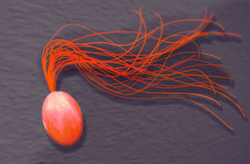Biology:Pyrococcus
| Pyrococcus | |
|---|---|

| |
| Pyrococcus furiosus | |
| Scientific classification | |
| Domain: | |
| Kingdom: | |
| Phylum: | |
| Class: | |
| Order: | |
| Family: | |
| Genus: | Pyrococcus Fiala and Stetter 1986
|
| Type species | |
| Pyrococcus furiosus Fiala and Stetter 1986
| |
| Species | |
| |
Pyrococcus is a genus of Thermococcaceaen archaean.[1]
Description and significance
Pyrococcus has similar characteristics of other thermoautotrophican archaea such as Archaeoglobus, and Methanococcus in the respect that they are all thermophilic and anaerobic. Pyrococcus differs, however, because its optimal growth temperature is nearly 100 °C and dwells at a greater sea depth than the other archaea. Studying Pyrococcus helps give insight to possible mechanisms used to endure extreme environmental conditions like high temperatures and high pressure.
Phylogeny
| 16S rRNA based LTP_06_2022[2][3][4] | 53 marker proteins based GTDB 08-RS214[5][6][7] | ||||||||||||||||||||||||||||||||||||||||||||||||||||||||||||||||||||||||
|---|---|---|---|---|---|---|---|---|---|---|---|---|---|---|---|---|---|---|---|---|---|---|---|---|---|---|---|---|---|---|---|---|---|---|---|---|---|---|---|---|---|---|---|---|---|---|---|---|---|---|---|---|---|---|---|---|---|---|---|---|---|---|---|---|---|---|---|---|---|---|---|---|---|
|
|
Genome structure
Three of the Pyrococcus species have been sequenced. P. furiosus is the largest containing 1.9Mb followed by P. abyssi with 1.8Mb and P. horikoshii with 1.7Mb.[citation needed] The genomes encode for many different metabolic enzymes which gives themselves a wider spectrum of living conditions because they can transport and metabolize a wide range of organic substances. Variation was detected between species as well.
Cell structure and metabolism
The cells of Pyrococcus are about 0.8–2 μm and are slightly irregular cocci in shape. They show a polar grouping of flagella and are enveloped by an S-layer enclosing a periplasmic space around the cytoplasmic membrane. Pyrococcus species are anaerobic but vary slightly concerning their metabolism. Peptide fermentation is the principle metabolic pathway however, growth has been observed for P. furiosus and P. abyssi on starch, maltose, and pyruvate but not for P. horikoshii. While the presence of elemental sulfur is not needed for growth, growth is enhanced with the addition of So.
Ecology
Pyrococcus species inhabit environments with extremely high temperatures such as Hydrothermal vents. Optimal growth conditions include a pH level of about 7, a salt concentration around 2.5%, and a temperature around 98 °C. Growing in temperatures this high, it is easy to see why they are anaerobic since at these boiling temperatures hardly any oxygen will be available. In the example of Hydrothermal vents, where P. abyssi has been found, there is no sunlight and the pressure is around 200 atm in addition to the extremely high temperature.
See also
References
- ↑ See the NCBI webpage on Pyrococcus. Data extracted from the "NCBI taxonomy resources". National Center for Biotechnology Information. http://ftp.ncbi.nih.gov/pub/taxonomy/. Retrieved 2007-03-19.
- ↑ "The LTP". https://imedea.uib-csic.es/mmg/ltp/#LTP.
- ↑ "LTP_all tree in newick format". https://imedea.uib-csic.es/mmg/ltp/wp-content/uploads/ltp/LTP_all_06_2022.ntree.
- ↑ "LTP_06_2022 Release Notes". https://imedea.uib-csic.es/mmg/ltp/wp-content/uploads/ltp/LTP_06_2022_release_notes.pdf.
- ↑ "GTDB release 08-RS214". https://gtdb.ecogenomic.org/about#4%7C.
- ↑ "ar53_r214.sp_label". https://data.gtdb.ecogenomic.org/releases/release214/214.0/auxillary_files/ar53_r214.sp_labels.tree.
- ↑ "Taxon History". https://gtdb.ecogenomic.org/taxon_history/.
Further reading
Scientific journals
- Elshawadfy, Ashraf M.; Keith, Brian J.; Ooi, H'Ng Ee; Kinsman, Thomas et al. (27 May 2014). "DNA polymerase hybrids derived from the family-B enzymes of Pyrococcus furiosus and Thermococcus kodakarensis: improving performance in the polymerase chain reaction". Frontiers in Microbiology 5: 224–. doi:10.3389/fmicb.2014.00224. PMID 24904539.
- Fiala G; Stetter KO (1986). "Pyrococcus furiosus sp. nov. represents a novel genus of marine heterotrophic archaebacteria growing optimally at 100 °C". Arch. Microbiol. 145: 56–61. doi:10.1007/BF00413027.
- Zillig W; Holz I; Klenk HP; Trent J et al. (1987). "Pyrococcus woesei, sp. nov., an ultra-thermophilic marine Archaebacterium, representing a novel order, Thermococcales". Syst. Appl. Microbiol. 9 (1–2): 62–70. doi:10.1016/S0723-2020(87)80057-7.
Scientific books
Scientific databases
- PubMed references for Pyrococcus
- PubMed Central references for Pyrococcus
- Google Scholar references for Pyrococcus
External links
- NCBI taxonomy page for Pyrococcus
- Search Tree of Life taxonomy pages for Pyrococcus
- Search Species2000 page for Pyrococcus
- MicrobeWiki page for Pyrococcus
- LPSN page for Pyrococcus
Wikidata ☰ Q2709870 entry
 |

